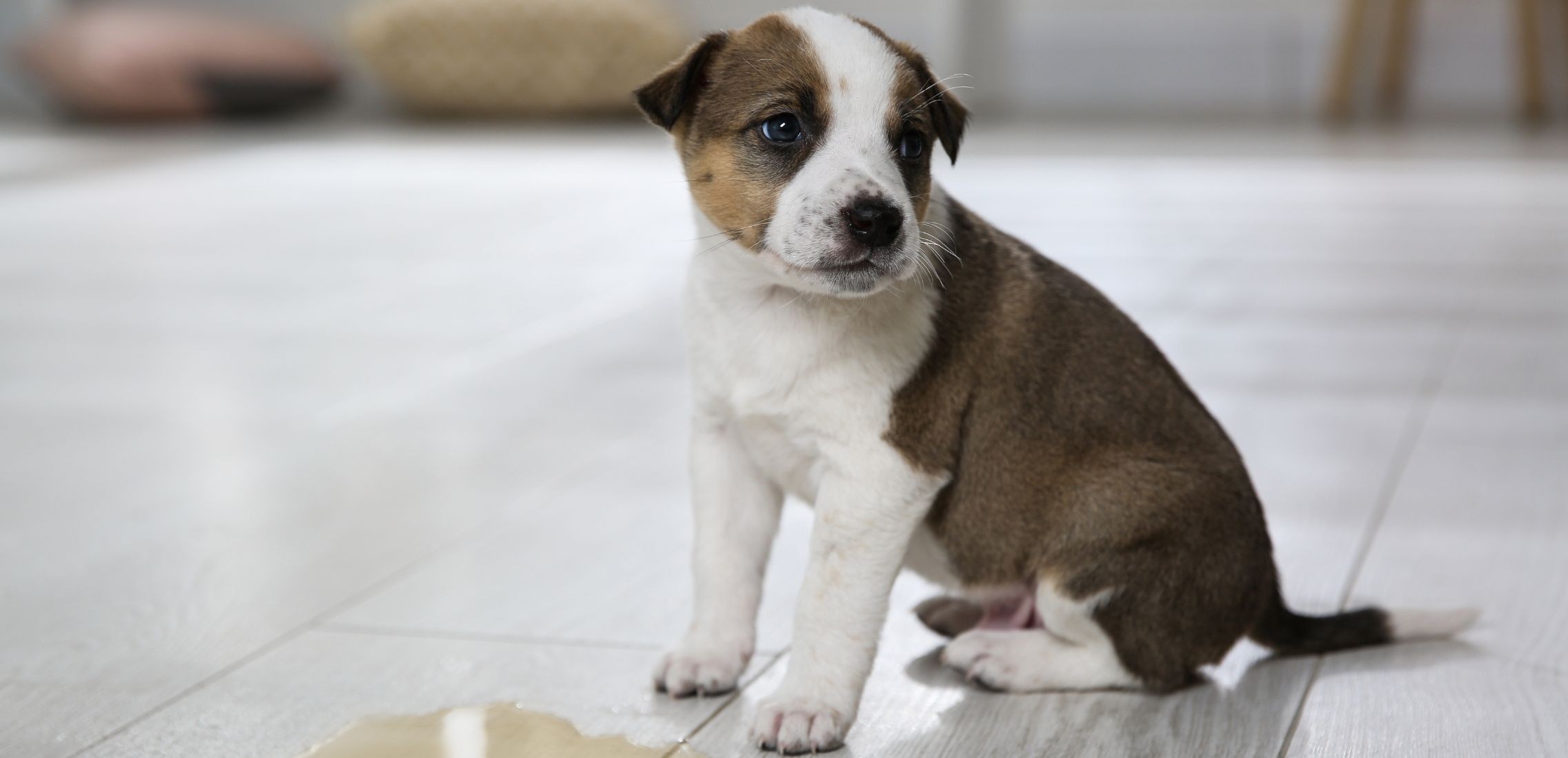Your Cart is Empty
Get Up To 35% OFF & Free Delivery
Get Up To 35% OFF & Free Delivery
Get Up To 35% OFF & Free Delivery

As pet parents, it’s our job to keep our pups happy and healthy, and as our fur babies can’t tell us what’s wrong, we have to pay attention to their behavior and acknowledge what might be wrong.
One of the most telling ways that your pup might be having some internal issues is through their toileting habits, particularly excessive urination. If your dog is peeing a lot it is often an early sign that something is amiss, whether physical, mental or emotional.
Being clued up on the reasons as to why this might be happening will help you catch things early and get your dog the help they need. We are going to look at some of the most common reasons why your dog is peeing too much, what to look for and how to help.
To start with, it helps to know how much your dog should be urinating at each stage. Dogs tend to pee roughly around 10-20ml for each pound of body weight, and so depending on the weight and size of your pooch you’ll be able to get a clearer idea of what their daily toilet routine will look like.
Of course this will vary per dog and change as they get older, so be prepared to alter your dog’s routine as they grow. Here is a basic guide for how often you can expect a dog to pee depending on their age:

Little ones cannot naturally hold their pee the way adult dogs can, and many pet owners follow the general rule that pups can hold their pee for an hour per the amount of months they are.
So a 2 month old may only be able to hold their pee for 2 hours, and so on. A puppy peeing a lot is to be expected, so with this in mind be sure to guide your pups to a toilet at regular intervals.
Adult Dogs
A healthy fully-grown dog tends to pee around 3 - 5 times a day, and it is recommended to leave them no more than 6 - 8 hours between pee breaks.
A dog’s need to pee may increase again as they get older, with health issues at risk of becoming more prevalent, as well as complications such as arthritis meaning they may struggle to get to the toilet in time.
Senior dogs should be taken to the toilet every 4 - 5 hours to give them a regular chance to relieve themselves.

So, your dog is peeing a lot more than usual - what could be the cause?
We have put together some of the leading causes of frequent urination in dogs to help you spot symptoms and catch issues early:

Urinary tract infections occur when bacteria enters the urethra, in dehydrated dogs or those who are lacking essential micronutrients. Symptoms include increased thirst, frequent painful urination, or even an avoidance of urination and excessive genital licking.
This condition causes a weakening of the urethral muscles, meaning that urine can pass through easier, making frequent and often uncontrollable urination a significant symptom.
A swollen prostate can put pressure on the bladder, resulting in a frequent urge to urinate in male dogs. This can be very uncomfortable for your dog, and so when symptoms arise it is worth getting your dog checked by a professional.
An extremely serious condition found in female dogs that can be life threatening if not treated properly. Pyometra causes the uterus to fill with bacteria and pus, with symptoms including vaginal discharge, increased thirst and urination, nausea and vomiting, decreased appetite and lethargy.


Cystitis is a condition that causes inflammation of the bladder, often caused by a bacterial urinary infection, symptoms include frequent and painful urination, urine with a strong odor and even bloody urine.
Kidney disease makes a dog more thirsty, resulting in more frequent urination. The disease can cause disorientation and weakness in your dog which, again, can contribute to toilet accidents.
Keep an eye on the color of your dog’s urine, as this can indicate whether your dog might be suffering from kidney disease. Pee that is dark yellow, brown or red should be investigated straight away.
One of the most obvious indicators of diabetes in dogs is increased thirst, which of course results in increased urination. Diabetes is a lifelong condition that requires close monitoring and management; if you notice these changes in your dog then get straight to the vet for testing.
Your dog’s altered toilet habits could be caused by something a bit more sinister, such as bladder cancer. Symptoms of bladder cancer include frequent urination that may only be passing in small amounts, difficulty urinating, as well as discolored or bloody urine.
Always consult your vet if you have any concerns about your dog’s toileting habits, as this will help you catch problems early and get your dog the treatment they need.


Cushing’s Disease is caused by an overproduction of cortisol in a dog’s adrenal glands, resulting in increased thirst and urination, an increased appetite, the forming of a pot belly, hair loss and muscle weakness or wastage, amongst other symptoms. This is an extremely serious and sometimes life-threatening condition that must be treated immediately.
Usually caused by an over-saturation of minerals such as calcium, bladder stones form when these minerals crystallize and form painful ‘stones’ in your dog’s bladder. These can vary in size and cause your dog to pee frequently but in very small amounts, and they may even pee blood.
Particularly present in spayed female dogs, hormones play a very important part in their internal system, and spaying can change this significantly. Always consult your vet if your spayed female is peeing excessively so that a proper diagnosis can be made and treated accordingly.
Canine Cognitive Dysfunction presents mostly in senior dogs, and could contribute to excessive urination. With reduced cognitive function, your dog could fall out of the habits they have learnt, perhaps forgetting where to pee, and maybe even forgetting to pee altogether, resulting in unwanted accidents.


Even small changes in your dog’s routine or environment can affect whether they feel safe or calm. Dogs are very sensitive to change, and their problems with peeing could be down to a particularly unpleasant spell of stress or anxiety.
Any changes in your dog’s peeing habits or behavior should be closely monitored, and we would always advise talking to your vet if you have even the smallest of concerns.
You may not even have to necessarily take your dog into a consultation, as your vet may be able to assess the symptoms your dog is experiencing with increased urination and prescribe possible solutions over the phone. What’s best is to check in with a qualified professional who will be able to advise you, based on your dog’s specific symptoms.
There are a few symptoms which can be particularly strong indicators that something is amiss inside your pup. Take a look at the list below and see if your dog is exhibiting any of the following behaviors. If so, it may be time to get in touch with your trusted veterinarian:

Little accidents around the home from dogs that are usually well house trained - for example, is your dog suddenly peeing indoors although they’ve been successfully potty trained? Or are they peeing in places they haven’t before?
Straining to urinate and not being able to pass any - keep a careful watch over your pup’s toilet habits and if they appear to be “trying to go” but not actually eliminating, this may be cause for concern.
Blood in their urine - even the smallest amount of blood in their urine should be cause for concern and you should get your pup checked out ASAP.
Excessive genital licking - a small amount of genital licking may just be your pup keeping themselves clean, but if they return to lick this area of the body again and again this is worth noting to your vet.
Increased thirst - dogs are pretty good at monitoring their own hydration levels and having a drink when they need to. However if you’ve noticed your pup is properly gulping down their drink more so than usual, check in with your vet about this as it may be a sign of an underlying health issue.
More or less appetite - if your dog has set mealtimes, this should be easy enough to monitor. If your pup demonstrates a lack of interest in their food or appears hungry even after having their set amount of food, this may be another sign that something is going on internally with your dog that is worth checking out.
Diarrhea and vomiting - these symptoms should be pretty obvious signs that your dog requires some form of medical support, so get them to a vet STAT.
If you start to notice a change in your dog’s peeing habits, mood or behavior, we would always recommend consulting your vet to rule out more serious causes. It could be that your dog’s issues are behavioral or emotional, at which time you can work to treat this at home. However, it is always best to rule out more severe health issues first.
A vet will know what to look for when you give them a list of symptoms, allowing them to run the relevant tests needed and advise of further treatment depending on the diagnosis. A bad outcome at the vets can be difficult for both owner and dog, but by keeping an eye and catching things early at home, you give your pup the best chance at a full recovery.
If you find that your dog’s toilet troubles are down to their emotional wellbeing, there are lots of things you can do to help get them back into a normal rhythm. Some potty training refreshers, professional dog training, creating a calmer home environment and a safe space for your dog can all contribute to creating a pee-free house.
See How Dog Owners Are Using These Leak-Free Potty Pads to Keep Their Homes Clean and Pups Happy
4.7 ⭐⭐⭐⭐⭐
Over 100,000 Dog Owners Saved Money With Potty Buddy™
The washable pee pads that absorb anything your dog throws at them, while keeping your floors and furniture stain-free.
✅ Super Absorbent and Leak-Proof
✅ Great for Potty Training
✅ Ideal for Puppies and Older Dogs
✅ Washable and Reusable For Years
✅ Save over $400/year by not buying disposables
-60 Day Money Back Guarantee-

⭐⭐⭐⭐⭐
-Diana D.
These pads are a life saver for my kitchen floor and bedroom carpet! Just ordered 2 more!




Check Out Our Most Popular Content